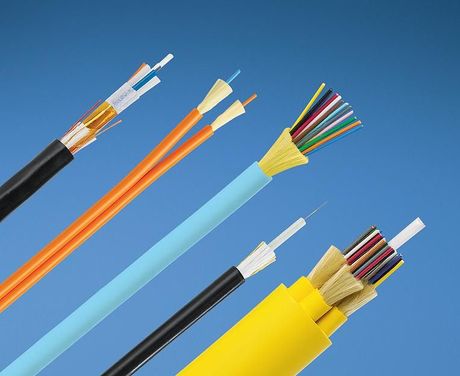Specifying industrial fibre-optic cable

Fibre-optic cabling is applicable in any industrial environment where high-speed, high-bandwidth data solutions are needed. It can be used for campus and in-building data backbones to anchor an operation’s ethernet, and also for point-to-point digital signal transmission. This cabling uses ruggedised jackets, often polyvinyl chloride (PVC) or chlorinated polyethylene (CPE), to ensure optimal performance in the face of extreme temperatures; exposure to UV/sunlight, oil and solvents; and crushing impact.
Benefits
Fibre-optic cabling is superior in terms of its high bandwidth, low attenuation and complete electrical noise immunity, allowing more information to be carried across the network without interruption. Fibre-optic cables are also smaller and lighter than copper cables, extremely durable and intrinsically safe, with no risk of spark hazards.
Alternatives
Typical alternatives for connecting data networks with fibre-optic cables include copper ethernet or automation cables. While copper cabling is suitable for the majority of industrial data transmission needs, both alternatives can stimulate potential failure points due to electrical noise, such as electromagnetic interference and radiofrequency interference, as well as limit bandwidth capacity and signal transmission distance.
Types of cables
Fibre-optic cabling can be segmented based on design criteria and installation environment:
- Loose-tube cables lay thinly coated fibre strands into unitised thermoplastic tubes, giving the fibre strands the flexibility to move within the tubes and the cable the ability to stand up to outdoor temperatures and harsh environments.
- Tight-buffered cables contain an individual buffer on each fibre stand, allowing for easy handling and quick termination. For common small fibre counts, this design delivers a smaller cable diameter than loose-tube cables and is best suited to indoor environments. The most common designs for tight-buffered cabling are distribution and breakout.
Singlemode fibre strands are designed to interface with laser optic light sources for distances beyond 300 m, while multimode strands are designed to interface with LED and vertical-cavity surface-emitting laser (VCSEL) light sources for short-distance cabling runs.
Installation
For industrial installations, it is critical to consider and evaluate the environment. When fibre cabling is running alongside power and a tray-rated 600 V control and instrumentation cable, a double-jacketed, heavy-duty, all-dielectric cabling design is preferable. If cabling requires extra physical protection or is slated for direct burial, steel-corrugated or aluminium interlocked armour can be applied to protect cabling from the elements, such as jagged rock or rodent chew-through.
Hysteresis in pressure calibration: what you need to know
Pressure calibration is crucial for ensuring the accuracy and reliability of process instruments...
Heat exchangers expand ginger beer production in Bundaberg
Bundaberg Brewed Drinks outgrew its production facility, so ensuring the equipment in its new...
Sampling gases and volatile liquids: essential strategies
Following gas sampling best practices can improve product output and reduce fugitive emissions.











